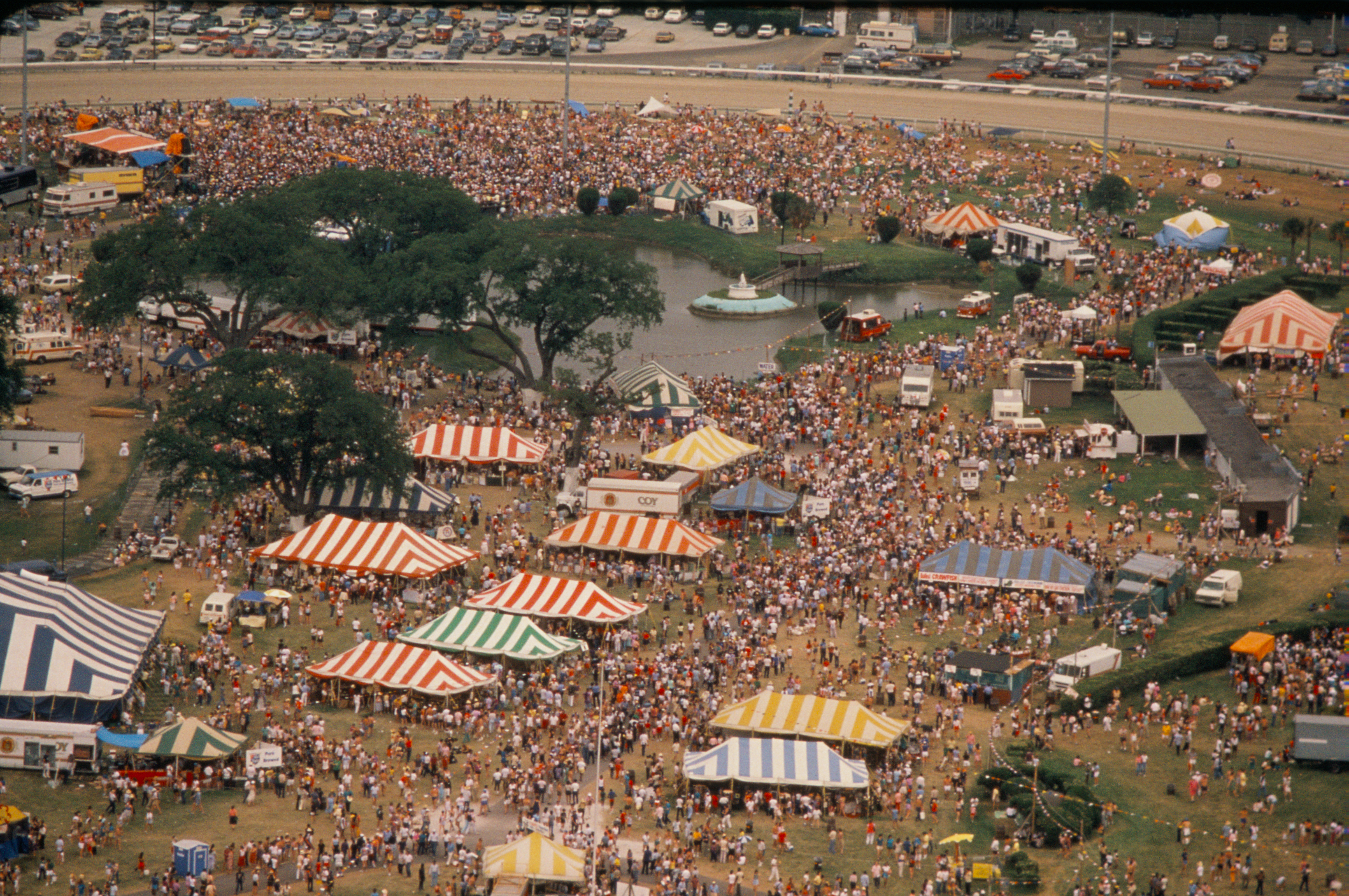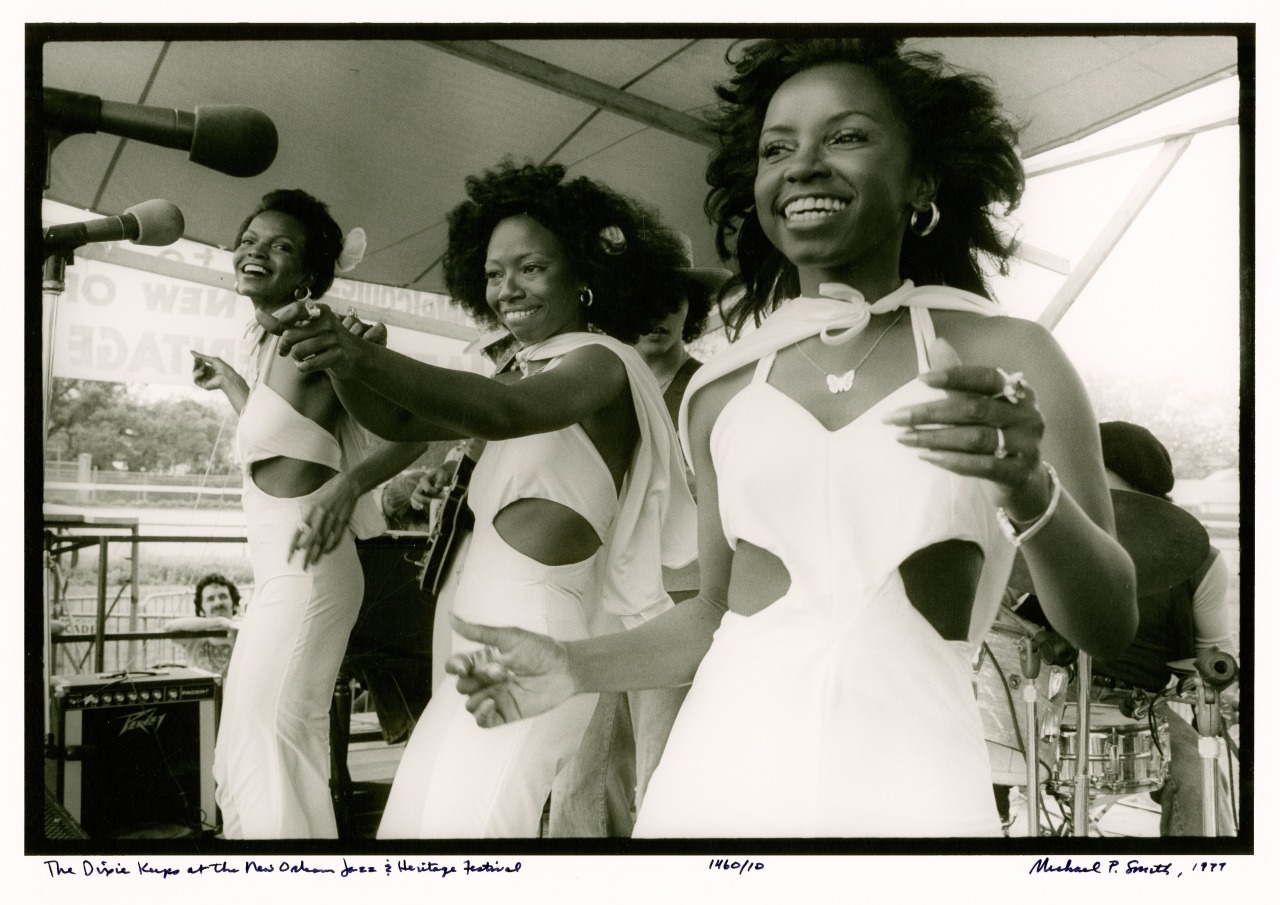Editor’s Note: The following series “All about Jazz” is a week-long series curated by Rena Repenning as part of the Digital Research Internship Program in partnership with ViaNolaVie. The DRI Program is a Newcomb Institute technology initiative for undergraduate students combining technology skillsets, feminist leadership, and the digital humanities.
Yes, this is the time when we’d be swarmed with floral shirts, drinking mango freezes, and sweating to our favorite beats in the sun, but due to COVID-19, the annual New Orleans Heritage & Jazz fest is postponed until Fall 2020. However, that doesn’t mean we all won’t be getting down and dancing in our living spaces. WWOZ will broadcast for 8 days-8 hours each (11am-7pm), the same days and hours as the originally-scheduled Jazz Fest (April 23-26 and April 30-May 3). So turn up the volume and get down to our Nola sounds! To also get you in the mood, we are bringing you a virtual Jazz Fest from the fests of the past. Originally starting in 1970, Jazz Fest is a staple in New Orleans culture and showcases musicians and talent, new and old. Happy Jazz, everyone, and we can’t wait to dance with you again in the hot hot sunshine (and pouring down rain, of course!)
This article was originally published on ViaNolaVie on 5/16/2019.

©New Orleans Jazz and Heritage Archive, photo by Harold Baquet, 1986
Fifty years after its founding, with almost a half-million annual attendance, New Orleans Jazz & Heritage Festival presented by Shell continues to be fabulously funky. Inconveniences, including scant parking and snakelike bathroom lines, heat, humidity, torrential rains and slogging across dusty or muddy grounds, make the Jazz Fest experience simultaneously exhausting and exhilarating, testing any jazz lover’s mettle.
First, there is the basic task of finding one’s way around, clutching a crumpled schedule and fairgrounds map. In the old days, it was possible to see where you were heading. Now, fest-goers swarm like clouds of bees, attracted by the strains of syncopated bass lines and Afro-Caribbean rhythms, lighting here and there, gathering honey from multiple stages. Sounds meld from one area to another while second-line dancers carrying umbrellas and Mardi Gras Indians in beaded suits suddenly appear from out of nowhere. Wear your shrimp boots, a sunhat and a cool shirt, you’ll be all right.
The essence of Jazz Fest hasn’t changed since 1970 when the tourism industry called on Newport Jazz Festival producer George Wein to develop an income-generating music festival in Congo Square (then called Beauregard Square). Instead, Wein proposed a “heritage fair,” featuring Louisiana music, food and locally produced arts and crafts. Consulting with Ellis Marsalis, Richard B. “Dick” Allen, curator of Tulane University’s Hogan Jazz Archives, and Harry Souchon, he hired Allison Miner, a jazz archive staffer, and Quint Davis, a Tulane ethnomusicology student, to recruit local performers.
“At the press conference announcing that initial 1970 Jazz Fest, Wein made a bold prediction: ‘New Orleans, in the long run, should become bigger than Newport in jazz festivals. Newport was manufactured, but New Orleans is the real thing,'” Keith Spera recently reported in the New Orleans Advocate.
Pete Fountain and Clyde Kerr orchestras played that first Wednesday on a midnight riverboat trip. Preservation Hall Jazz Band, Duke Ellington, Pete Fountain, Al Hirt, Clifton Chenier, Fats Domino and The Meters commanded The Louisiana Heritage Fair’s four open-air stages, and Mahalia Jackson dropped by and sang with the Eureka Brass Band. Davis invited Mardi Gras Indians—including vocalist Bo Dollis, Big Chief of The Wild Magnolias. (That was the first occasion Indians had performed outside their culture.)
“Our first year, there was no stage,” Quint Davis, executive producer, told the Los Angeles Times. “There was no PA system. We had an upright piano in the grass.” There was no budget to cover hotel rooms for out-of-town performers who stayed in organizers’ homes.
The first, five-day Jazz Fest attracted only 350 attendees, paying $3 admission. The production lost thousands of dollars, but was deemed a success.
From Offbeat’s 2019 Jazz Fest Bible: “I remember one time, me [James] Singleton and David Torkanowsky were hired to back up Snooks Eaglin. There was a wooden stage with bleachers on both sides, and a big puddle of mud the middle. We were waiting for David “T.” Snooks didn’t bring a guitar chord or a case or anything. He kept asking, ‘Where’s David? Where’s David?’ So, it’s downbeat time, ‘Ladies and gentlemen…’ All of a sudden I looked out through the crowd, and I could see across this big giant mud puddle, David running towards the stage. So, he hits the mud puddle, man, and he falls in, but he jumps up, keeps running, and comes up with one shoe on and jumps on the stage.”

The Dixie Cups, 1977 Photograph by Michael P. Smith ©The Historic New Orleans Collection
In 1972, the festival moved to the New Orleans Fair Grounds and Racetrack. Bruce Fleury, Tulane professor emeritus, fondly recalls those early days: “The fest gave me a chance to learn what New Orleans music was all about. And that was great not only for me, but for all the hundreds of out-of-towners who went home feeling that our city was a special place. The first day each weekend became one of my favorite times to go, because it was devoted entirely to local acts. The crowds were light, the music was great, no big lines at the food booths or beer tents. For many years, my son and I went almost every day, both weekends. One of our traditions was to stop at the Louisiana Crafts tent and buy a songbird carving from Irvan Perez, one of Louisiana’s greatest decoy carvers. By some miracle, those birds survived Katrina, and they always remind me of how much the fest meant to us.”
As the festival grew, attendees arrived from all over the country and the world. During the early years, Jazz Fest needed loans to stay solvent. The fairgrounds burned down in 1993 and the fest lost money when heavy rains halted performances. Corporate sponsorships were necessary to pay bigger acts that would bring throngs of music lovers. A partnership with promoter AEG Live and the Royal Dutch Shell sponsorship guaranteed the show would go on. But the festival’s growth disappointed some locals. “The bigger Jazz Fest became, the less fun it was to go…I miss the fest the way it used to be,” Fleury said. “It was a fantastic local event, but now it’s just one more venue for big name acts.”
WWOZ-FM Brass Pass holder Sid Jacobson holds a different perspective. “The big name headliners definitely bring me to the fest on days when I otherwise might not go. I also think it’s terrific to see their generosity bringing others and local favorites to join them on stage,” he said. Jacobson recounts: “I do remember Count Basie a long time ago. Later, memories include some of the giants of jazz: The Mahavishnu Orchestra, George Benson and others. Later, Sonny Rollins in the Jazz Tent, Earth, Wind and Fire on the Congo Square stage. Al Jarreau, Santana, Stevie Wonder, Bob Dylan, as well as local bands: Astral Project, The Neville Brothers/Meters, the Marsalis family in any configuration. My absolute favorites: Bruce Springsteen right after Katrina, possibly my favorite show. Esperanza Spalding in the Jazz Tent, one of the most stunning performances ever.”
In 2019, Jazz Fest featured 688 acts, two-thirds from Louisiana. A 2018 study estimated its total economic impact at almost $400 million.
This year, the Smithsonian Folkways label produced a five-disc collection, “Jazz Fest: The New Orleans Jazz & Heritage Festival Box Set,” focusing on five decades of great performances with essays and annotations by Keith Spera, Karen Celestan, Robert Cataliotti, Jeff Place, Rachel Lyons, and Jon Pareles, plus photos spanning the festival’s history (published here on ViaNolaVie). The box set delivers the sights and sounds of being at Jazz Fest with five discs, more than 300 minutes of music, rekindling memories for the hundreds of thousands who return to New Orleans year after year.
Photos courtesy of The New Orleans Historic Collection and Jazz & Heritage Foundation Archive.
 Waves of Change–The Impact of Political Tides on Louisiana’s Environmental Future
Healthy Gulf has been a cornerstone in safeguarding Louisiana’s natural and human resources through sustainable and equitable practices. But a new threat looms with Governor Jeff Landry’s recent consolidation proposal, which aims to merge crucial coastal management with the Department of Energy and Natural Resources. Writer Leah Claman delves into the complexities of this proposal, breaking it down for those unfamiliar with environmental policy, and sheds light on what this could mean for the future of Louisiana’s coast and its communities.
Waves of Change–The Impact of Political Tides on Louisiana’s Environmental Future
Healthy Gulf has been a cornerstone in safeguarding Louisiana’s natural and human resources through sustainable and equitable practices. But a new threat looms with Governor Jeff Landry’s recent consolidation proposal, which aims to merge crucial coastal management with the Department of Energy and Natural Resources. Writer Leah Claman delves into the complexities of this proposal, breaking it down for those unfamiliar with environmental policy, and sheds light on what this could mean for the future of Louisiana’s coast and its communities.
 Earthtalk: Retaining starts with repurposing – Green Light New Orleans
This piece spotlights Green Light New Orleans, a non-profit dedicated to promoting collective engagement in sustainability practices in local households. Author Brett Steinberg discusses the non-profit's Rain Barrel program, effectively combining art and water conservation.
Earthtalk: Retaining starts with repurposing – Green Light New Orleans
This piece spotlights Green Light New Orleans, a non-profit dedicated to promoting collective engagement in sustainability practices in local households. Author Brett Steinberg discusses the non-profit's Rain Barrel program, effectively combining art and water conservation.

I attended the jazz festival from 1974 thru 1978 and have numerous pictures from that era. I think the first name for that festival was the “Louisiana Heritage Festival” not “New Orleans Jazz and Heritage Festival”. Comment please.